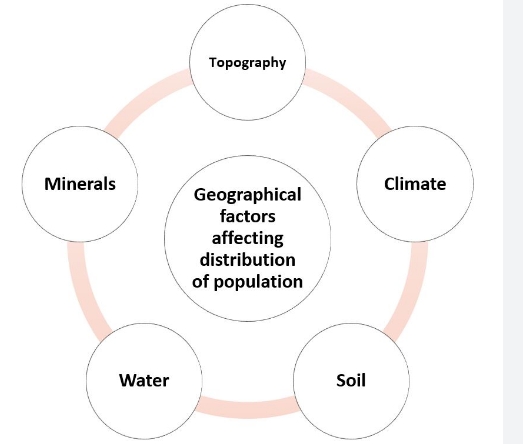

CBSE Class 8 Geography Notes Chapter 6: Chapter 6 of CBSE Class 8 Geography, titled "Human Resources," explores the significance of humans as a valuable resource. It discusses how population size, distribution, and growth are influenced by birth and death rates, migration, and life expectancy.
The chapter also highlights the role of education, health, and skills in transforming population into a productive human resource. It explains the uneven distribution of the global population and the factors affecting it, such as climate, terrain, and availability of resources. The chapter underscores the importance of developing human resources for economic development and social well-being.CBSE Class 8 Geography Notes Chapter 6 Overview
Chapter 6 of CBSE Class 8 Geography, "Human Resources," focuses on the concept of human beings as the most valuable resource on Earth. The chapter begins by explaining the term "human resources," which refers to the people who contribute to the economy and society through their skills, knowledge, and abilities. It emphasizes that the quality of human resources depends on education, healthcare, and training, which can transform a population into a productive and skilled workforce.The chapter then explores the distribution of the global population, highlighting that it is uneven due to factors such as climate, topography, soil fertility, and availability of water and minerals. Regions with favorable conditions tend to have a higher population density, while harsh environments like deserts, mountains, and dense forests have lower population densities.
CBSE Class 8 Geography Notes Chapter 6 PDF
The CBSE Class 8 Geography Notes Chapter 6 Human Resources underscores the importance of planning and managing human resources to achieve sustainable development and improve the quality of life for all.CBSE Class 8 Geography Notes Chapter 6 PDF
CBSE Class 8 Geography Notes Chapter 6 Human Resources
Here we have provided CBSE Class 8 Geography Notes Chapter 6 Human Resources - The greatest resource of a country is its people. The abundance of nature only becomes noteworthy when humans find value in it. People become "resources" because of their needs and capabilities. Therefore, the most valuable resource is human capital.Distribution of Population
The distribution pattern of people on Earth is referred to as the pattern of population distribution. About 30% of the earth's surface is home to more than 90% of the world's people. There is an uneven distribution of the population. There are densely populated areas and less populated areas. Southeast Asia, northeastern North America, and Europe are the most populated regions. High altitude regions, tropical deserts, high mountains, and equatorial woods are home to very few people. North of the Equator is home to a far larger population than south of it. Almost 75% of the world's population resides on the continents of Asia and Africa. Merely ten countries are home to 60% of the global population. There are more than 100 million individuals in each of them.
North of the Equator is home to a far larger population than south of it. Almost 75% of the world's population resides on the continents of Asia and Africa. Merely ten countries are home to 60% of the global population. There are more than 100 million individuals in each of them.
Density of Population
The density of population, typically given as people per square metre, is the number of people residing in a unit area of the Earth's surface. The global population density is 51 people per square kilometre on average. The regions with the densest populations include South-Central Asia, East Asia, and South East Asia.Factors Affecting the Distribution of Population
Geographical Features
Topography
Plains are more favoured by people for living than mountains and plateaus because they are better suited for manufacturing, services, and farming. The world's most heavily populated regions are the Ganga lowlands; the Andes, Alps, and Himalayas are lightly populated.Climate
People usually avoid extreme climates that are very hot or very cold. Examples: Sahara Desert, polar regions of Russia, Canada and Antarctica.Soil
Fertile soils provide suitable land for agriculture. Examples: Densely populated fertile plains such as Ganga and Brahmaputra in India, Hwang-He, Chang Jiang in China and the Nile in Egypt.Water
People like to reside in places with easy access to freshwater. The world's river valleys are home to a large population, whilst deserts are sparsely populated.Minerals
Areas with mineral deposits are more populated. Example: Diamond mines in South Africa and the discovery of oil in the Middle East led to the settling of people in these areas.Social, Cultural and Economic Factors
Social: Denserly populated areas with better housing, healthcare, and educational resources include Pune. Cultural: People are drawn to locations with religious or cultural importance. Examples include Vatican City, Jerusalem, and Varanasi. Economic: Because industrial districts offer job prospects, a lot of people are drawn to them. Examples of densely inhabited areas are Mumbai in India and Osaka in Japan.Population Change
A shift in the total number of individuals at a certain point in time is referred to as a population change. The population of the planet is not steady. Due to variations in the number of births and deaths, it has multiplied. The population of the world increased gradually but consistently up to the 1800s. Many babies were born, but many of them also passed away at a young age. Causes include a lack of adequate healthcare facilities, a lack of enough food to feed everyone, and farmers' inability to produce enough food to meet demand. The population increased somewhat as a result of this. The world population peaked in 1804, at one billion people, and experienced a population explosion when it surpassed three billion people in 1959, a span of 155 years. Also, the population doubled to reach 6 billion in 1999, around 40 years later. The primary causes of this expansion were improved access to food and medication, a decline in the number of deaths, and a relatively high birth rate. Migration is a further factor in changes in population size. People can relocate both within and between nations. Emigrants are individuals who depart from a nation, whereas immigrants are those who enter a nation. Immigration has increased the population of nations like Australia and the United States of America. One nation where the population has decreased as a result of emigration or out-migration is Sudan. International migration generally tends to flow from less developed to more developed countries in quest of greater job possibilities. Many people may relocate from rural to urban locations within a country in quest of jobs, educational opportunities, and access to healthcare.
The population increased somewhat as a result of this. The world population peaked in 1804, at one billion people, and experienced a population explosion when it surpassed three billion people in 1959, a span of 155 years. Also, the population doubled to reach 6 billion in 1999, around 40 years later. The primary causes of this expansion were improved access to food and medication, a decline in the number of deaths, and a relatively high birth rate. Migration is a further factor in changes in population size. People can relocate both within and between nations. Emigrants are individuals who depart from a nation, whereas immigrants are those who enter a nation. Immigration has increased the population of nations like Australia and the United States of America. One nation where the population has decreased as a result of emigration or out-migration is Sudan. International migration generally tends to flow from less developed to more developed countries in quest of greater job possibilities. Many people may relocate from rural to urban locations within a country in quest of jobs, educational opportunities, and access to healthcare.
Patterns of Population Change
Global population growth rates differ—despite the fact that the world's population is expanding quickly overall, not all nations are seeing this rise. Kenya has high rates of both births and deaths, along with rapid population expansion. Death rates have decreased as a result of better health care, but high birth rates continue to fuel high growth rates. Due to low birth and mortality rates, population growth is slowing down in some nations, such as the United Kingdom.Population Composition
The density of a population has minimal bearing on its economic progress. Japan and Bangladesh are extremely inhabited. However, Bangladesh is not as economically developed as Japan. Individuals differ in terms of their age, gender, economic level, occupation, health, and reading level. The structure of the population is referred to as population composition. The population's makeup provides information on the number of men and women, age groups they belong to, educational attainment, types of occupations they work in, income levels, and health conditions. The population pyramid and the age-sex pyramid can be used to study a nation's demographic makeup. A pyramid of population sizes displays • The population is split up into age groups, such as those between the ages of 5 and 9 and 10 and 14. • The share of the overall population in each of those categories, broken out by gender. The number of children (under 15) reflects the number of births and is displayed at the bottom. The top's size indicates both the number of deaths and the number of elderly individuals (those over 65). The number of dependents in a nation is another thing that the population pyramid reveals. Dependents can be divided into two categories: young dependents (those under 15 years old) and elderly dependents (those beyond 65 years old). People who are working age engage in the economy.The population pyramid of Kenya
Kenya's population pyramid is broad at the base and progressively narrows towards the top due to the country's high birth and death rates. This is due to the fact that, despite the fact that numerous children are born, a sizable portion of them pass away during infancy, very few grow up, and there are very few elderly people.Population Pyramid of India
Because more babies live to adulthood in nations like India, where death rates are declining (particularly among the very young), the pyramid is broader in the younger age groups. The pyramid for India shown above illustrates this. These populations have a sizable proportion of youth, which contributes to a robust and growing labour force. Low fertility rates in nations like Japan cause the base of the pyramid to narrow. A lower death rate makes it possible for more individuals to live long lives. The youth, gifted with an optimistic outlook and skill and energy, represent a country's future.Benefits of CBSE Class 8 Geography Notes Chapter 6
The benefits of studying Chapter 6, "Human Resources," in CBSE Class 8 Geography include:Understanding Population Dynamics : The chapter provides insights into how population size and distribution are influenced by factors like birth and death rates, migration, and life expectancy, helping students grasp the complexities of demographic changes.
Importance of Human Capital : It emphasizes the significance of education, health, and skills in transforming the population into a productive resource, highlighting the role of human capital in economic growth.
Global Population Distribution : Students learn about the uneven distribution of the global population and the reasons behind it, such as climate, terrain, and resource availability, which enhances their understanding of geographical and social patterns.
Sustainable Development Awareness : The chapter encourages students to think about sustainable development by illustrating how a well-managed population can lead to economic growth and improved quality of life, fostering responsible global citizenship.
Critical Thinking : By exploring the challenges of population growth, such as resource strain and unemployment, the chapter encourages students to think critically about solutions for managing human resources effectively.
CBSE Class 8 Geography Notes Chapter 6 FAQs
What is a short note on human resources for Class 8?
What is human resource class 8 geography chapter 6?
Why are human resources important Class 8 answers?
What is the summary of Chapter 6 of Class 8 geography?










